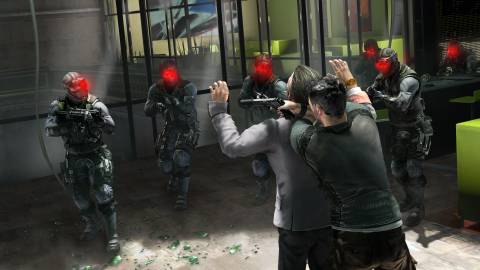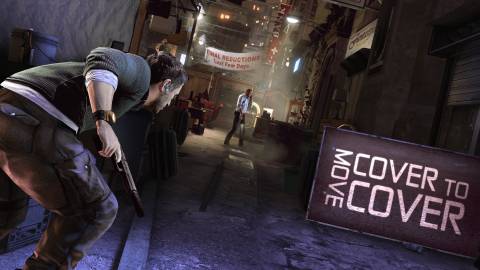
The opening sequence in Conviction hammers home what we already know about the metamorphosis of Sam Fisher from Third Echelon company man to a bitter outsider intent on using his formidable and dangerous abilities to mete out some semblance of justice from those he believes have wronged him. There's an early, eerie flashback at the start of Conviction that serves double duty of introducing some of the game's new mechanics as well as reopening the gaping wound of Sam's daughter's death. Sam explains to his young daughter, afraid of the dark, that it's easier to see the monsters coming and stay hidden when the lights are out--a fundamental truth for Splinter Cell that still rings true in Conviction.
Moments later, the Fisher house plays host to a pair of the world's unluckiest home invaders, who quickly fall victim to Sam's new mark-and-execute ability. This pretty much does what it says, letting Sam mark two enemies and then auto execute them with the press of a button. It's perfect for guards who seem to have a knack for patrolling in pairs, though abuse of this system is tempered somewhat by the fact that you need to first take down another enemy hand-to-hand before mark-to-execute is made available. Incapacitating enemies up-close is also a single-press process, and though I didn't find it hard to keep Sam charged up, it's worth noting that this stuff appears to be from the very, very beginning of the game.

Infiltrating the mansion through an open window, I made my way through the mansion, shooting out lights, snapping necks, and using a busted-off car mirror to check under doors before proceeding to the next room. When I did get spotted, disappearing was made significantly easier with the “last known position” feature, which creates a silhouette of Sam where the enemies think you are. Last known position isn't strictly a damage control feature, though--I also found it handy for drawing groups of enemies to a specific location, and then sneaking right past them. The mission cultivated with an interrogation sequence with Sam's target, which punches up outpours of information and exposition with quick flashes of extreme violence. There doesn't seem to be a whole lot to the interrogation process, but I'll be damned if it's not immensely satisfying to smash a guy's head through a piano's keys to get him to talk.
In some ways, Splinter Cell is eschewing some of the mechanisms that made past games such a specific and measured experience with Conviction, which may be disheartening for fans still pining for the good ol' days of stealth action. What it might be losing in mechanical sophistication, though, it's more than making up for with a much more visceral, and personal, experience.